
试卷代号:1065 中央广播电视大学2011一2012学年度第二学期“开放本科”期末考试 英语教学法(2)试题 2012年7月 注意事项 一、将你的学号、姓名及分校(工作站)名称填写在答题纸的规定栏 内。考试结束后,把试卷和答题纸放在桌上。试卷和答题纸均不得带 出考场。监考人收完考卷和答题纸后才可离开考场。 二、仔细读懂题目的说明,并按题目要求答题。答案一定要写在答 题纸的指定位置上,写在试卷上的答案无效。 三、用蓝、黑圆珠笔或钢笔答题,使用铅笔答题无效。 Information for the examinees: This examination consists of 2 parts.They are: Section I:Basic theories and principles 40 points) SectionⅡ:Lesson plan(60 points) The total marks for this examination are 100 points.Time allowed for completing this examination is 90 minutes. ● There will be no extra time to transfer answers to the Answer Sheet;Therefore,you should write ALL your answers on the Answer Sheet as you do each task. 486
试卷代号 6 5 中央广播电视大学 2 0 11 2学年度第二学期"开放本科"期末考试 英语教学法 )试题 2012 年7 ...... 事项 、将你的学号、姓名及分校(工作站)名称填写在答题纸的规定栏 内。考试结束后,把试卷和答题纸放在桌上。试卷和答题纸均不得带 出考场。监考人收完考卷和答题纸后才可离开考场。 二、仔细读懂题目的说明,并按题目要求答题。答案一定要写在答 题纸的指定位置上,写在试卷上的答案无效。 三、用蓝、黑圆珠笔或钢笔答题,使用铅笔答题无效。 Information for the examinees: • This examination consists of 2 parts. They are Sectipn I z Basic theories and principles (40 points) Section II : Lesson plan (60 points) • The total marks for this examination are 100 points. Time allowed for completing this examination is 90 minutes. • There will be no extra time to .transfer answers to the Answer Sheet 9 Therefore 9 you should write ALL your answers on the Answer Sheet as you do each task. 486
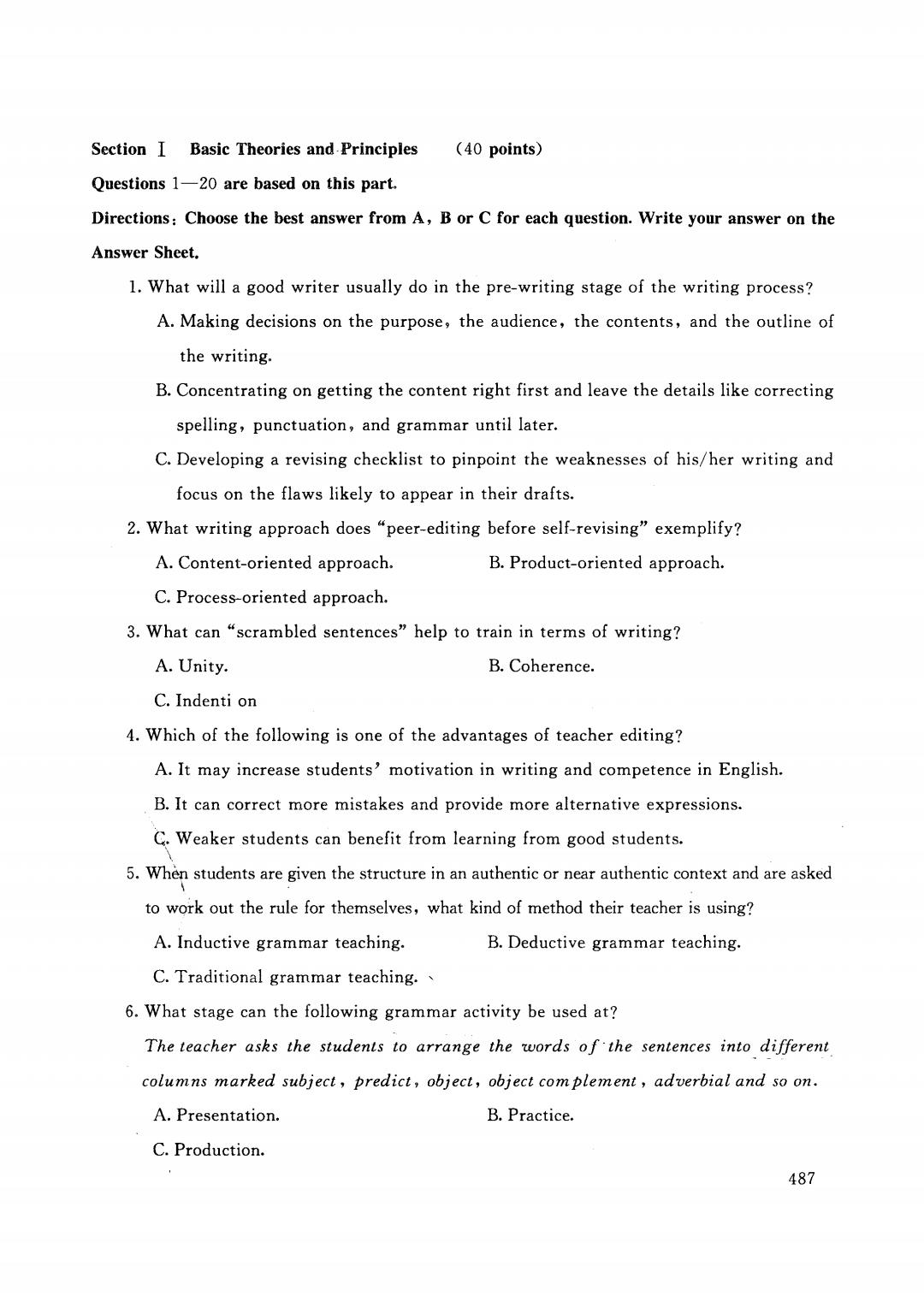
Section I Basic Theories and.Principles (40 points) Questions 1-20 are based on this part. Directions:Choose the best answer from A,B or C for each question.Write your answer on the Answer Sheet. 1.What will a good writer usually do in the pre-writing stage of the writing process? A.Making decisions on the purpose,the audience,the contents,and the outline of the writing. B.Concentrating on getting the content right first and leave the details like correcting spelling,punctuation,and grammar until later. C.Developing a revising checklist to pinpoint the weaknesses of his/her writing and focus on the flaws likely to appear in their drafts. 2.What writing approach does "peer-editing before self-revising"exemplify? A.Content-oriented approach. B.Product-oriented approach. C.Process-oriented approach. 3.What can "scrambled sentences"help to train in terms of writing? A.Unity. B.Coherence. C.Indenti on 4.Which of the following is one of the advantages of teacher editing? A.It may increase students'motivation in writing and competence in English. B.It can correct more mistakes and provide more alternative expressions. C.Weaker students can benefit from learning from good students. 5.When students are given the structure in an authentic or near authentic context and are asked to work out the rule for themselves,what kind of method their teacher is using? A.Inductive grammar teaching. B.Deductive grammar teaching. C.Traditional grammar teaching. 6.What stage can the following grammar activity be used at? The teacher asks the students to arrange the words of the sentences into different columns marked subject,predict,object,object complement,adverbial and so on. A.Presentation. B.Practice C.Production. 487
Section I Basic Theories andPrinciples Questions 1-20 are based on this part. (40 points) Directions: Choose the best answer from A , B or C for each question. Write your answer on the Answer Sheet. 1. What will a good writer usually do in the pre-writing stage of the writing process? A. Making decisions on the purpose , the audience , the contents, and the outline of the writing. B. Concentrating on getting the content right first and leave the details like correcting spelling , punctuation , and grammar until later. C. Developing a revising checklist to pinpoint the weaknesses of his/her writing and focus on the flaws likely to appear in their drafts. 2. What writing approach does "peer-editing before self-revising" exemplify? A. Content-oriented approach. C. Process-oriented approach. B. Product-oriented approach. 3. What can "scrambled sentences" help to train in terms of writing? A. Unity. C. Indenti on B. Coherence. 4. Which of the following is one of the advantages of teacher editing? A. It may increase students' motivation in writing and competence in English. B. It can correct more mistakes and provide more alternative expressions. C. Weaker students can benefit from learning from good students. 5. Wht'mstudents are given the structure in an authentic or near authentic context and are asked to wqrk out the rule for themselves, what kind of method their teacher is using? A. Inductive grammar teaching. C. Traditional grammar teaching.\ B. Deductive grammar teaching. 6. What stage can the following grammar activity be used at? The teacher asks the students to arrange the words of-the sentences into different columns marked subject , predict , object , object comρlement adverbial and so on. A. Presentation. C. Production. B. Practice. 487
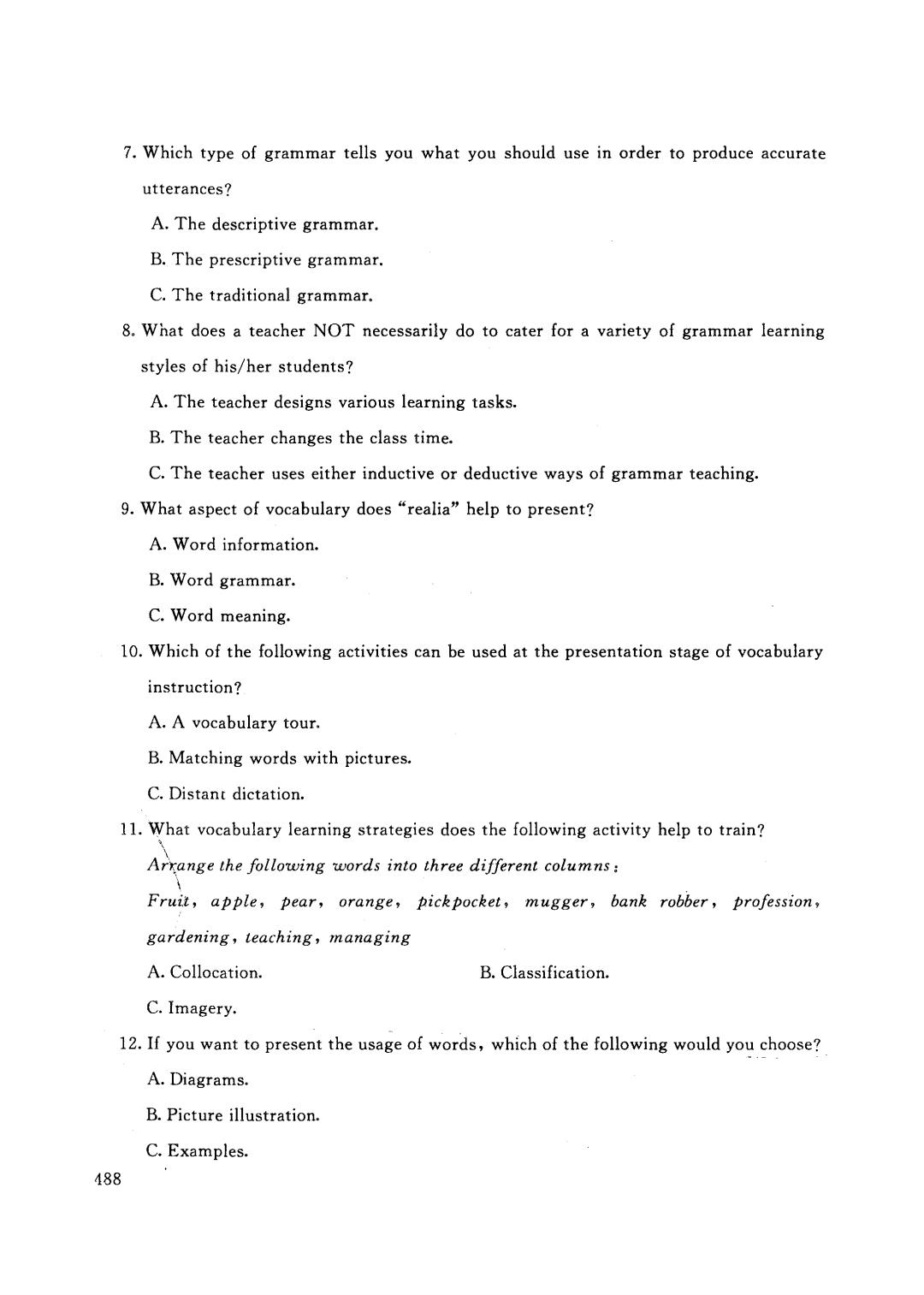
7.Which type of grammar tells you what you should use in order to produce accurate utterances? A.The descriptive grammar. B.The prescriptive grammar. C.The traditional grammar. 8.What does a teacher NOT necessarily do to cater for a variety of grammar learning styles of his/her students? A.The teacher designs various learning tasks. B.The teacher changes the class time. C.The teacher uses either inductive or deductive ways of grammar teaching. 9.What aspect of vocabulary does "realia"help to present? A.Word information. B.Word grammar. C.Word meaning. 10.Which of the following activities can be used at the presentation stage of vocabulary instruction? A.A vocabulary tour. B.Matching words with pictures. C.Distant dictation. 11.What vocabulary learning strategies does the following activity help to train? Arrange the following words into three different columns: Fruit,apple,pear,orange,pickpocket,mugger,bank robber,profession, gardening,leaching,managing A.Collocation. B.Classification. C.Imagery. 12.If you want to present the usage of words,which of the following would you choose? A.Diagrams. B.Picture illustration. C.Examples. 488
7. Which type of grammar tells you what you should use in order to produce accurate utterances? A. The descriptive grammar. B. The prescriptive grammar. C. The traditional grammar. 8. What does a teacher NOT necessarily do to cater for a variety of grammar learning styles of his/her students? A. The teacher designs various learning tasks. B. The teacher changes the class time. C. The teacher uses either inductive or deductive ways of grammar teaching. 9. What aspect of vocabulary does "realia" help to present? A. Word information. B. Word grammar. c. Word meaning. 10. Which of the following activities can be used at the presentation stage of vocabulary instructIOn? A. A vocabulary tour. B. Matching words with pictures. C. Distant dictation. mugger, bank robber , ro s s 11. What vocabulary learning strategies does the following activity help to train? Ar吃angethe卢llowing words into three different columns: FruiJ ρle pear, orange 户ickpocket gardening , teaching , managing A. Collocation. B. Classification. C. Imagery. 12. If you want to present the usage of words, which of the following would you choose? A. Diagrams. B. Picture illustration. C. Examples. • 488
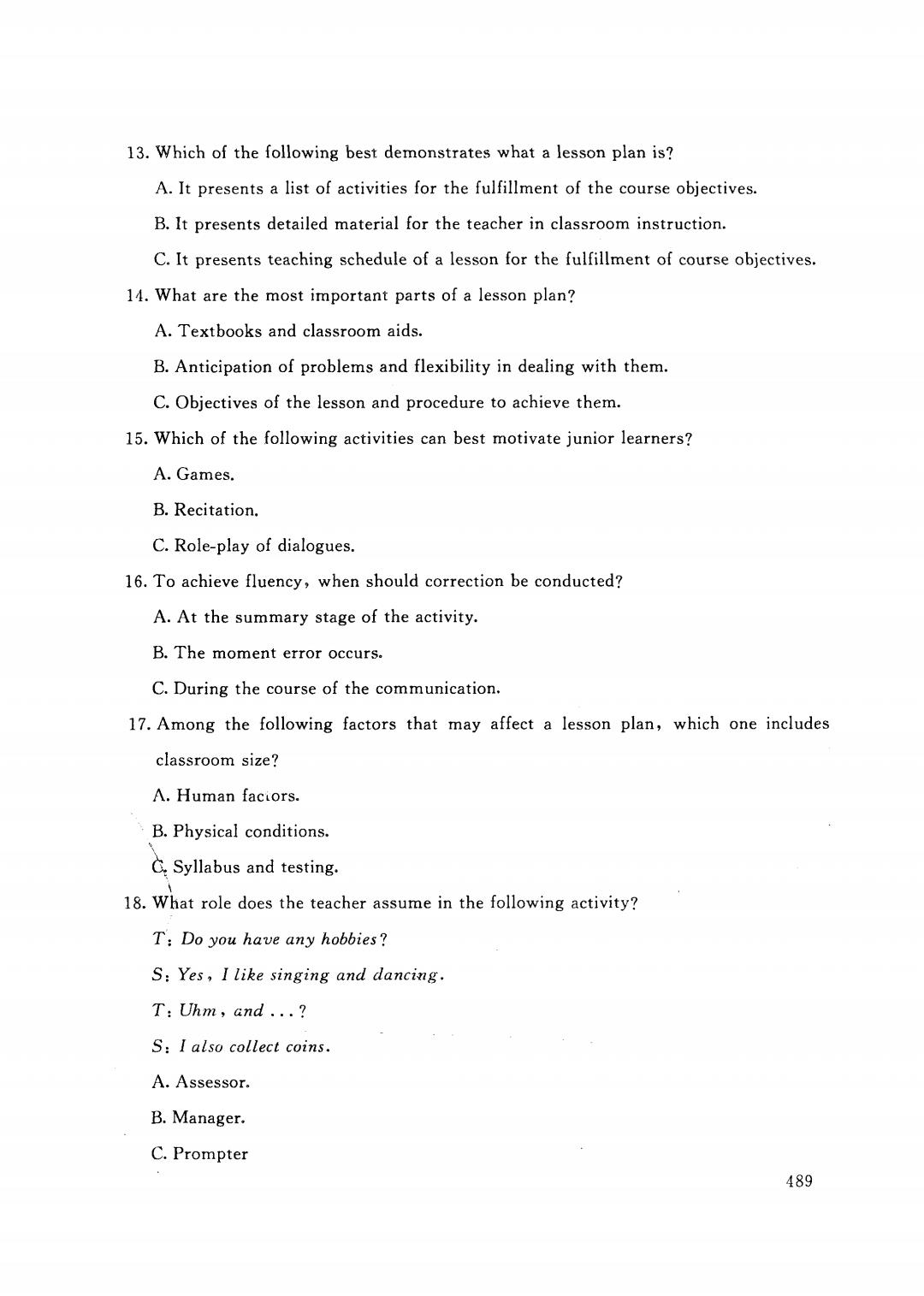
13.Which of the following best demonstrates what a lesson plan is? A.It presents a list of activities for the fulfillment of the course objectives. B.It presents detailed material for the teacher in classroom instruction C.It presents teaching schedule of a lesson for the fulfillment of course objectives. 14.What are the most important parts of a lesson plan? A.Textbooks and classroom aids. B.Anticipation of problems and flexibility in dealing with them. C.Objectives of the lesson and procedure to achieve them. 15.Which of the following activities can best motivate junior learners? A.Games. B.Recitation. C.Role-play of dialogues. 16.To achieve fluency,when should correction be conducted? A.At the summary stage of the activity. B.The moment error occurs. C.During the course of the communication. 17.Among the following factors that may affect a lesson plan,which one includes classroom size? A.Human faciors. B.Physical conditions. C.Syllabus and testing. 18.What role does the teacher assume in the following activity? T:Do you have any hobbies? S:Yes,I like singing and dancing. T:Uhm,and...? S:I also collect coins. A.Assessor. B.Manager. C.Prompter 489
13. Which of the following best demonstrates what a lesson plan is? A. It presents a list of activities for the fulfillment of the course objectives. B. It presents detailed material for the teacher in classroom instruction. C. It presents teaching sch巳dule of a lesson for the fulfillment of course objectives. 14. What are the most important parts of a lesson plan? A. Textbooks and classroom aids. B. Anticipation of problems and flexibility in dealing with them. C. Objectives of the lesson and procedure to achieve them. 15. Which of the following activities can best motivate junior learners? A. Games. B. Recitation. C. Role-play of dialogues. 16. To achieve fluency , when should correction be conducted? A. At the summary stage of the activity. B. The moment error occurs. C. During the course of the communication. 17. Among the following factors that may affect a lesson plan , which one includes classroom size? A. Human fa Ctors. B. Physical conditions. ll b u and testing. 18. What role does the teacher assume in the following activity? T: Do you have any hobbies? S: Yes , I like singing αnd dancing. T: Uhm , and . . . ? S: I also collect coins. A. Assessor. B. 岛1anager. C. Prompter 489
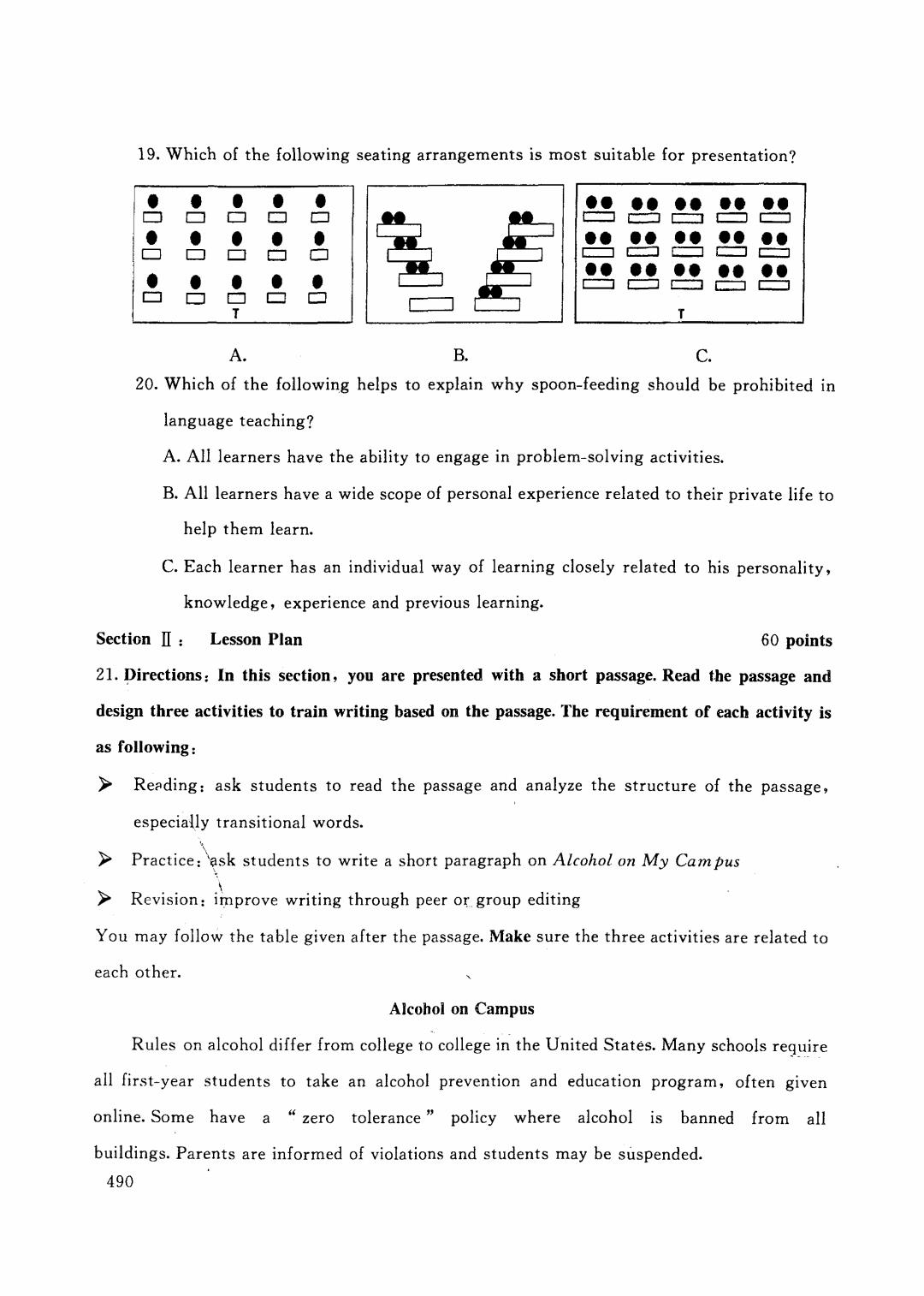
19.Which of the following seating arrangements is most suitable for presentation? 吕 ●● ●● 当 吕吕 A. B. C. 20.Which of the following helps to explain why spoon-feeding should be prohibited in language teaching? A.All learners have the ability to engage in problem-solving activities. B.All learners have a wide scope of personal experience related to their private life to help them learn. C.Each learner has an individual way of learning closely related to his personality, knowledge,experience and previous learning. SecticnⅡ:Lesson Plan 60 points 21.Directions:In this section,you are presented with a short passage.Read the passage and design three activities to train writing based on the passage.The requirement of each activity is as following: Reading:ask students to read the passage and analyze the structure of the passage, especially transitional words. >Practice:ask students to write a short paragraph on Alcohol on My Cam pus Revision:improve writing through peer or group editing You may follow the table given after the passage.Make sure the three activities are related to each other. Alcohol on Campus Rules on alcohol differ from college to college in the United States.Many schools require all first-year students to take an alcohol prevention and education program,often given online.Some have a "zero tolerance"policy where alcohol is banned from all buildings.Parents are informed of violations and students may be suspended. 490
19. Which of the following seating arrangements is most suitable for presentation? •• •• ee T c. [ •• _I .e Ie ee ee ee=.:J ee [一一一 ee I→ Ie I _~ e• 「→ ee ee--~ B. C 3 • • • • • o o o o o o • o • • • • o o o • • • • • D CJ T A. 20. Which of the followi~g helps to explain why spoon-feeding should be prohibited in language teaching? A. All learners have the ability to engage in problem-solving activities. B. Alllearners have a wide scope of personal experience related to their private life to help them learn. c. Each learner has an individual way of learning closely related to his personality , knowledge , experience and previous learning. Section IT: Lesson Plan 60 points 21. Directions: In this section , you are presented with a short passage. Read the passage and design three activities to train writing based on the passage. The requirement of each activity is as following: > ReClding: ask students to read the passage and analyze the structure of the passage , t F especial,ly transitional words. Practice: \~sk students to write a short paragraph on Alcohol on My Cam pus Revision: iI:nprovewriting through peer or. group editing You may follow the table given after the passage. Make sure the three activities are related to > > \ Alcohol on Campus each other. 00 qu reqJ TAE 'n +ta4t, eQM ManVd EUC , G qu e un +LE 4E·tn , Egbe n ''EA ETA TAOm coIEiegbe 4EL0 O 'EBA a--EArfA O--n Ru es on a co all first~year students to take an alcohol prevention and education program , often gIven online. Some have a " zero tolerance " policy where alcohol IS banned from all buildings. Parents are informed of violations and students may be suspended. ' 490
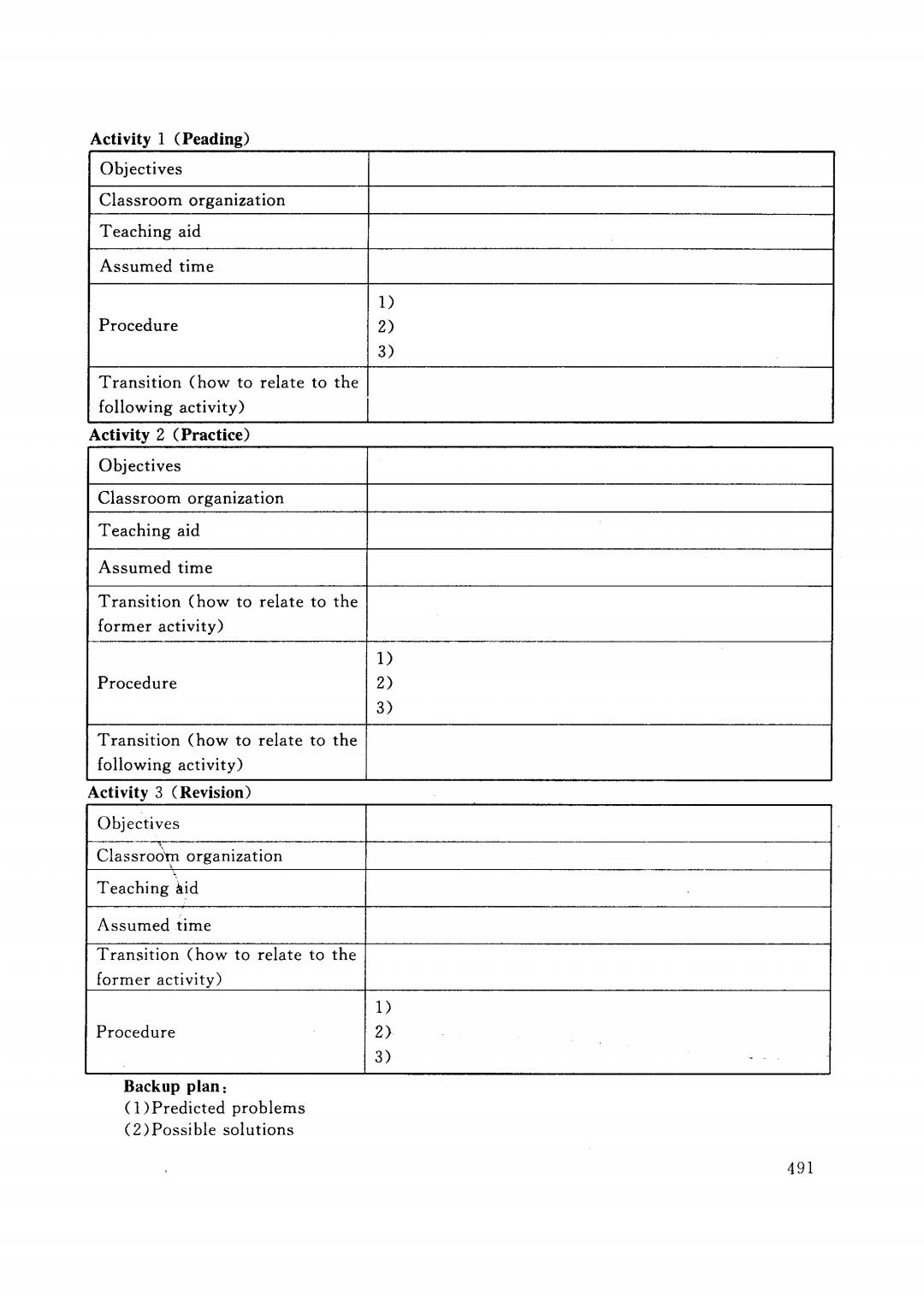
Activity 1 (Peading) Objectives Classroom organization Teaching aid Assumed time 1) Procedure 2) 3) Transition (how to relate to the following activity) Activity 2 (Practice) Objectives Classroom organization Teaching aid Assumed time Transition (how to relate to the former activity) 1) Procedure 2) 3) Transition (how to relate to the following activity) Activity 3 (Revision) Objectives Classroom organization Teaching aid Assumed time Transition (how to relate to the former activity) 1) Procedure 2) 3) Backup plan: (1)Predicted problems (2)Possible solutions 491
Activity 1 (Peading) Objectives Classroom organization Teaching aid Assumed time 1) Procedure 2) 3) Transition (how to relate to the following activity) Activity 2 (Practice) Objectives Classroom organization Teaching aid Assumed time Transition (how to relate to the former activity) 1) Procedure 2) 3) Transition (how to relate to the following activity) Activity 3 (Revision) Objectives ClassroOyporganization Teaching !tid Assumed time Transition (how to relate to the former activity) 1) Procedure 2) 3) Backup plan: (1) Predicted problems (2)Possible solutions 491
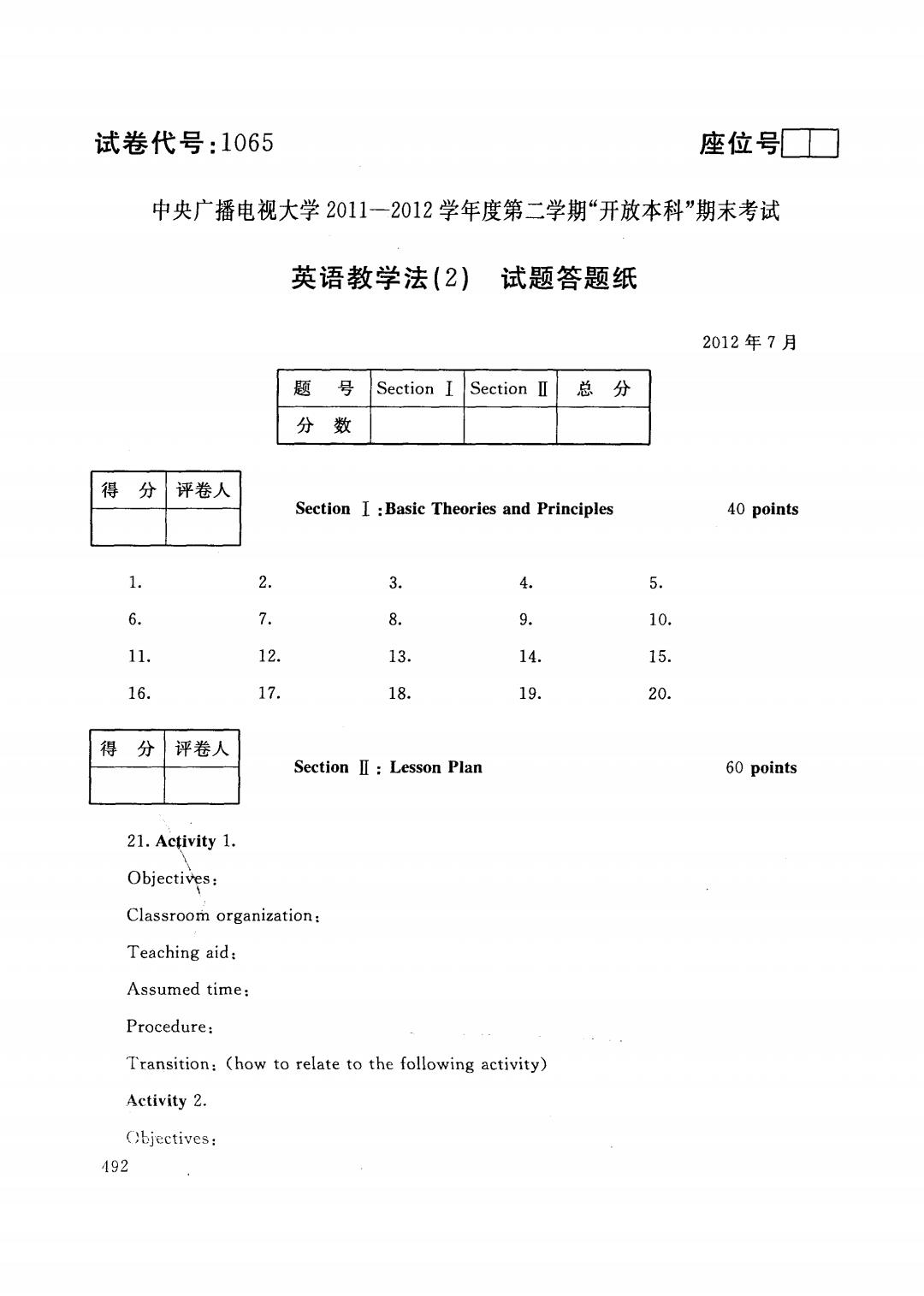
试卷代号:1065 座位■■ 中央广播电视大学2011一2012学年度第二学期“开放本科”期末考试 英语教学法(2) 试题答题纸 2012年7月 题号 Section I Section II 总分 分数 得分 评卷人 Section I Basic Theories and Principles 40 points 1. 2. 3. 4. 5. 6. 7. 8. 9. 10. 11. 12. 13. 14. 15. 16. 17. 18. 19 20. 得 分 评卷人 SectionⅡ:Lesson Plan 60 points 21.Activity 1. Objectives: Classroom organization: Teaching aid: Assumed time: Procedure: Transition:(how to relate to the following activity) Activity 2. Cbjectives: 492
试卷代号 5座位号 中央广播电视大学 2 0 11 2012 学年度第二 开放 英语教学法 )试题答题纸 2012 年7 Section I Section II 得分|评卷入 Section I :Basic Theories and Principles 40 points 1. 2. 7. 9. 10. 11. 12. 3. 8. 13. 4. 5. 6. 14. 15. 16. 17. 18. 19. 20. 得分|评卷人 Section II : Lesson Plan 60 points o Uban.1za On Jrtlgu AEE t-b , a Teaching aid: Assumed time: Procedure: Transition: (how to relat巳to the following activity) Activity 2. Objectives: 192
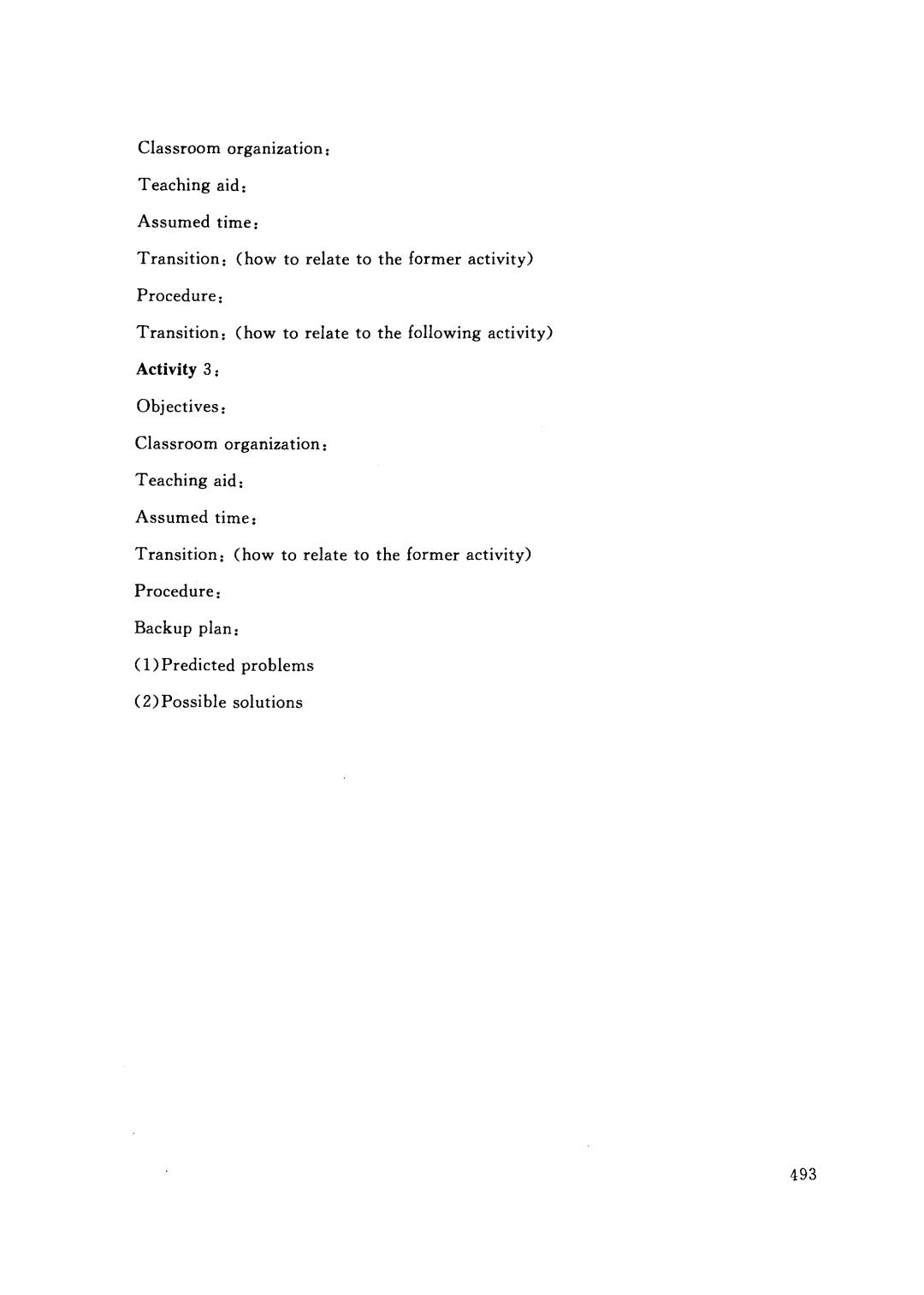
Classroom organization: Teaching aid: Assumed time: Transition:(how to relate to the former activity) Procedure: Transition:(how to relate to the following activity) Activity 3: Objectives: Classroom organization: Teaching aid: Assumed time: Transition:(how to relate to the former activity) Procedure: Backup plan: (1)Predicted problems (2)Possible solutions 493
Classroom organization: Teaching aid: Assumed time: Transition: (how to relate to the former activity) Procedure , Transition: (how to relate to the following activity) Activity 3: Objectives: Classroom organization: Teaching aid: Assumed time: Transition: (how to relate to the former activity) Procedure: Backup plan: (1) Predicted problems (2)Possible solutions 493

试卷代号:1065 中央广播电视大学2011一2012学年度第二学期“开放本科”期末考试 英语教学法(2) 试题答案及评分标准 (供参考) 2012年7月 Section I Basic Theories and Principles 40 points 本题为单选题,共20个小题,总计40分,每题2分。 1.A 2.C 3.B 4.B 5.A 6.B 7.B 8.B 9.C 10.B 11.B 12.C 13.C 14.C 15.A 16.A 17.B 18.C 19.B 20.A SectionⅡ:Lesson Plan 60 points 21.参考答案和评分标准 Activity 1 (Reading) Objectives:to analyze the content and writing of the passage Classroom organization:individual work to pair work Teaching aid:multi-media or OHP Assumed time:8 minutes Procedure: (1)Assign the task (13) "Now,class.Today,you are going to write on Alcohol on My Campus.Before you take up your pens,let's read the text first.See what is included in the passage and how it is developed.First read by yourself.When you have finished,check your understanding with your partner.Now 4 minutes for your work". (2)Students work individually to read the text and then work in pairs to talk about the content and the writing mechanism of the text.(4') 494
试卷代号 6 5 中央广播电视大学 11 2012 年度 二学期 末考 英语教学法 试题答案及评分标准 Section I (供参考) Basic Theories and Principles 2012 年7 40 points 本题为单选题,共 0个小题,总计 0分,每题 2分。 LA 6. B 11. B 16. A Section II 2. C 7. B 12.C 17. B : Lesson Plan 3. B 8. B 13. C 18. C 4. B 9. C 14. C 19.B 5. A 10. B 15. A 20. A 60 points 1. 参 考 案和 Activity 1 (Reading) Objectives: to analyze the content and writing of the passage Classroom organization: individual work to pair work Teaching aid: multi-media or OHP Assumed t{me : 8 minutes Procedure , \ (1) Assign the task 口') "Now , class. Today , you are going to write on Alcohol on My Campus. Before you take up your pens , let' s read the text first. See what is included in the passage and how it is developed. First read by yourself. When you have finished , check your understanding with your partner. Now 4 minutes for your work". (2)Students work individually to read the text and then work in pairs to talk about the content and the writing mechanism of the text. (4') 494

(3)Feedback (3') Call on individual pairs to report their work.Then the teacher presents the content and the development of the passage with the multimedia or OHP. Transition: (4)T:"OK.When we introduce something,we can include a topic sentences,then .. Now,can you write something to introduce Alcohol on My Campus. Activity 2 (Writing) Objectives:to apply the mechanism of writing to introduce another topic. Classroom organization:individual work Teaching aid:no Assumed time:8 minutes Transition (5)Assign the task (1'): (continuing 4)"I'd like you to work individually.First think of what you can include in your passage.Then write a short passage using the skills you learn in this text. Procedure (6)Individual writing (5') Students work individually to write about Alcohol on Their Campus.While the students are writing,the teacher can circulate around to monitor and render assistance where necessary. Transition: (7)T:"Have you finished?If yes,I'd like you to exchange your writing with your partner..” Activity 3 (Revision) Objectives:to make improvements through peer editing. Classroom organization:pair work Teaching aid:multimedia Assumed time:6 minutes 495
(3) Feedback (3') Call on individual pairs to report their work. Then the teacher presents the content and -the development of the passage with the multimedia or OHP. Transition , (4)T: "OK. When we introduce something , we can include a topic sentences, then 0.. Now , can you write something to introduce Alcohol on My Campus. Activity 2 (Writing) Objectives: to apply the mechanism of writing to introduce another topic. Classroom organization: individual work Teaching aid: no Assumed time , 8 minutes Transition (5) Assign the task (1') : (continuing 4) "I' d like you to work individually. First think of what you can include in your passage. Then write a short passage using the skills you learn in this text. " Procedure (6)Individual writing (5') Students work individually to write about Alcohol on Their Campus. While the students ar巳writing the teacher can circulat巳around to monitor and 巳ncler assistance where necessary. Transition: V'OU gb w--+L'n e vdou +tO EXpL a Eb YOUVA W VA 4L.1n 'bK h IA, 'd 'aa.1 vdemb EG paEA E , · mqu 'n ·· a T HavE vdou partner. " Activity 3 (Revision) Objectives: to make improvements through peerediting. Classroom organization: pair work Teaching aid: multimedia Assumed time , 6 minutes 495